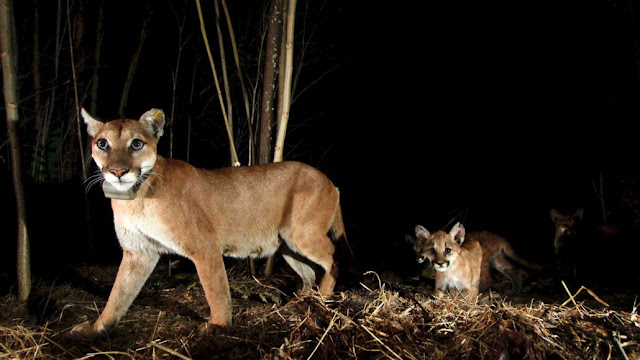The Woolsey Fire in California in 2018 caused local mountain lions to cross roads more frequently.
Mountain lions have no interest in humans or the developed areas we enjoy. However, following a wildfire in California in 2018, local lions took more risks, crossing roads more frequently and moving around more during the day, researchers report in Current Biology on October 20. It's yet another way that human development could put pressure on vulnerable wildlife, potentially pushing them toward our bumpers.
On November 8, 2018, the Woolsey Fire broke out near Los Angeles and burned more than 36,000 hectares in the Santa Monica Mountains. Nearly 300,000 people were evacuated, and three people died
as a result. Animals, including local mountain lions, fled the fire as well (Puma concolor). According to Rachel Blakey, a UCLA global change biologist, the fire was both a tragedy and a scientific opportunity. Many of the lions were fitted with tracking collars, which allowed scientists to study how the fire affected their behavior.
Nine of the 11 collared cougars in the area at the time escaped during the fire. "They have really large home ranges, so being able to cover many kilometers in a day is nothing to them," Blakey says.
The mountain lions avoided people no matter how fast they moved. P-64, a collared cat, initially fled the fire until he was close to a developed area. When given the choice between fire and people, the lion chose the latter. "That's where his movements ceased," Blakey observes. P-64's remains were later discovered by the park service. He'd burned his paws, and it's possible he starved to death because he couldn't hunt.
The scientists discovered that the nine lions who survived the fire and others who were collared afterward avoided the severely burned areas of their territories. The cats had little cover for stalking and ambushing prey with the vegetation gone.
Instead, the cougars stayed in unburned areas and avoided humans. They took more risks with human infrastructure, increasing their road crossings from three to five times per month on average.
 |
| Mountain lions in the Santa Monica Mountains crossed roads more frequently after the Woolsey Fire in 2018, a risky move that could endanger the cats' lives. PARK SERVICE NATIONAL |
These weren't just two-lane country roads. After the Woolsey Fire, the first collared lion successfully crossed Interstate 405, which has 10 lanes in places. And the big cats crossed US Route 101 once every four months, compared to once every two years before the fire. Their territories also overlapped more frequently, increasing the possibility of deadly encounters between the lone cats. And the normally nocturnal animals increased their activity during the day from 10% to 16% of their active time, increasing a lion's chances of encountering a human.
A road crossing is what Blakey refers to as a "risk mismatch." Lions in densely populated areas appear to regard the risk of encountering humans as more dangerous. However, "running across a freeway is much more likely to be fatal," she claims. This risk, when combined with the risk of colliding with other cats, can be fatal. In the months following the fire, one young, collared male was found dead on a freeway. He was running away from a fight with an older, uncollared male.
According to Winston Vickers, a wildlife research veterinarian at the University of California, Davis who was not involved in the study, intense burns like the Woolsey Fire highlight mountain lions' resilience. "They have amazing mobility, they can usually get away from the immediate fire, and they usually survive," he says. Changes in risk-taking, he believes, may reflect how confined the population is, hemmed in by human development in the mountains.
Wildlife crossings, such as the new Wallis Annenberg Wildlife Crossing over the 101, will hopefully provide a safer option for mountain lions to roam, though the main goal is to promote gene flow between lion populations, according to Blakey (SN: 5/31/16). It's important to have somewhere to run in a landscape where fire, humans, and highways all coexist.
CITATIONS
Mountain lions avoid burned areas and increasingly risky behavior after wildfire in a fragmented urban landscape, according to R. Blakey et al. Biology Today. doi:10.1016/j.cub.2022.08.082. Published online October 20, 2022.

